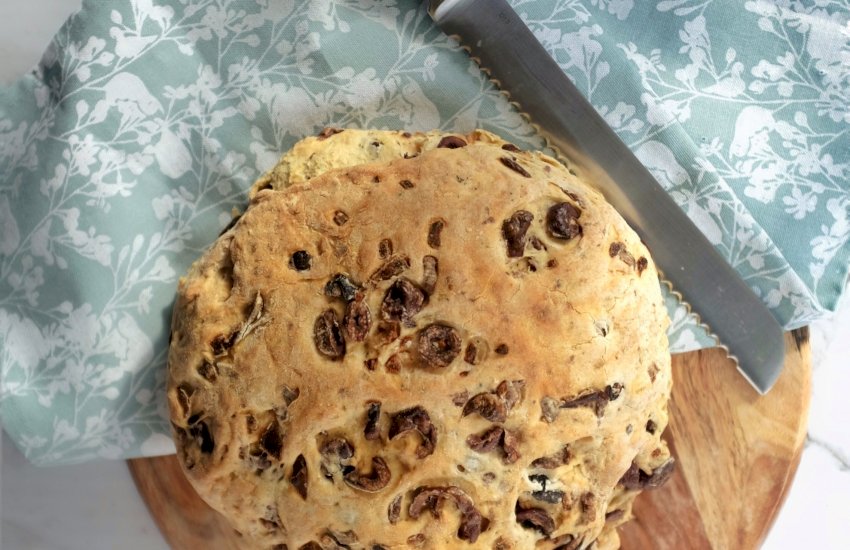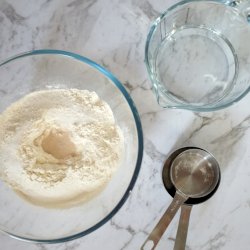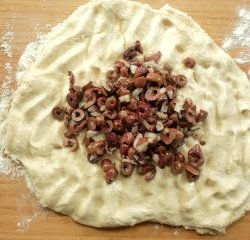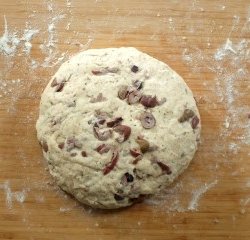Greek Style olive bread - Eliopsomo
GREEK STYLE OLIVE BREAD – ELIOPSOMO
OLIVE BREAD WITH A BEAUTIFUL HINT OF ROSEMARY
Who doesn’t love a warm piece of olive bread? Cooking in general is quite therapeutic for me but baking is even more so. The kneading process and the smell of yeast make me want to do a happy dance. I am no qualified baker, what I bake is just what I learnt from lots of trial and error. But hearing positive comments and a finished loaf of olive bread is definitely an indication that the recipe is good right? So here is what I’ve learnt…
Flour can be categorized based on how fine it is ground. Type “2” is coarse and the finer is type “00”. I use “00” flour for bread, which is not only finer but also less elastic. That makes the bread crunchier on the outside and not chewy. I usually make the dough at night so by the morning it is set and all i have to do is mix in the olives. Definitely cuts down the waiting time for Sunday breakfast.
We consume a lot of olives in our household so sometimes I buy the olives in a 1kg jar. In that case they are soaking in a brine which also has vinegar. In that case in preparation for the olive mixture I let them strain in a colander over a bowl until there is no more liquid.
Prep Time 20 mins
Cook Time 45 mins
Resting time 1 hr 20 mins
Total Time 1 hr
Ingredients
Bread
• 500 g “00” flour, extra for dusting
• 2 tsp instant dried yeast
• 1 tsp sugar
• 1 tsp salt
• 1 tbs olive oil
• 1 – 1 ¼ cups lukewarm water
Olive mixture
• 1 ½ cups pitted black olives roughly chopped, see my notes below
• ½ onion finely diced
• 1 tbs olive oil
• 1 tsp rosemary, I sometimes substitute this with dried mint
Instructions
Break making
1. Sift the flour in a large bowl, then add the yeast, salt and sugar. Mix all the dry ingredients with your hand to spread evenly. Make a well in the middle, add the oil and one cup of water initially, mixing well with your fingers or a wooden spoon.
2. Lightly flour a clean surface, bench or board, and tip the dough on it. Keep stretching and kneading with the end of your palm until the dough is consistent in appearance. If there is still flour then you may need to add a bit more water, do so by adding 1 tsp at a time. If the dough is too wet then add a bit more flour.
3. Once a smooth surface is achieved place the dough back in the bowl, cover with a towel. I usually add a blanket on top too if it is cold in the house. Allow the dough to proof for about an hour or until it has doubled in size. In the meantime prepare the olive mixture.
4. Once the dough is ready, tip it out on a lightly floured surface. Use your palm and finger tips to spread it out into a rectangular/round shape. Add half the olive mixture in the middle. Fold the corners/edges in the centre and press it down to spread out again. Repeat the process with the rest of the olives. As you combine it all together form it into a round shape.
5. The olives will cause the dough to be quite moist, lightly dust it with more flour if needed so that the outer surface is not wet. The one I made had a diameter of 17cm, hence the cooking time is based on that. Line a tray with baking paper, place the bread on there and let it rest again for 20min.
6. Preheat the oven, at the convection setting, at 160°C. Place the tray on the middle rack, cook for 35min and then turn the heat up to 200°C for the last 10-15min. Let it bake until it is evenly brown.
7. Place it on a cooling rack and let it cool down before cutting. Enjoy!
Olive mixture
Prepare the olive mixture by adding all the ingredients together. It is important that the olives are at room temperature so that it doesn’t disrupt the yeast’s activation. Hence if they were in the fridge prepare this first and leave it on the kitchen bench to reach room temperature.
Recipe Notes
I typically use pitted olives to reduce the prep time in having to take the pits out. If you are using olives brined in a jar then allow them to strain to remove all the liquid they’ve been soaking in. If you are using olives that are already marinated then do not add the extra olive oil in the mixture.
The onion ideally should be lightly fried for easy digestion however most of the times in this case I add it in the mixture raw.










